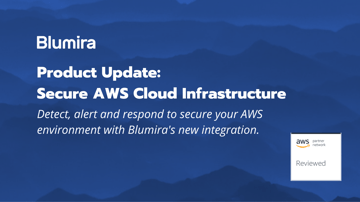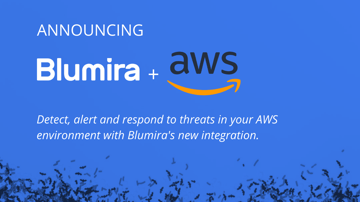- Product
Product Overview
Sophisticated security with unmatched simplicityCloud SIEM
Pre-configured detections across your environmentHoneypots
Deception technology to detect lateral movementEndpoint Visibility
Real-time monitoring with added detection & responseSecurity Reports
Data visualizations, compliance reports, and executive summariesAutomated Response
Detect, prioritize, and neutralize threats around the clockIntegrations
Cloud, on-prem, and open API connectionsXDR Platform
A complete view to identify risk, and things operational
- Pricing
- Why Blumira
Why Blumira
The Security Operations platform IT teams loveWatch A Demo
See Blumira in action and how it builds operational resilienceUse Cases
A unified security solution for every challengePricing
Unlimited data and predictable pricing structureCompany
Our human-centered approach to cybersecurityCompare Blumira
Find out how Blumira stacks up to similar security toolsIntegrations
Cloud, on-prem, and open API connectionsCustomer Stories
Learn how others like you found success with Blumira
- Solutions
- Partners
- Resources
What is privilege escalation and why is it important to understand for security? Privilege escalation is when an adversary uses a number of techniques to gain higher-level permissions within a system or network, often the stage after initial access and discovery.
Adversaries can often enter a network with unprivileged access, but require elevated permissions to follow through on their objectives, according to MITRE. They’ll often take advantage of system weaknesses, misconfigurations and vulnerabilities to gain elevated permissions.
When it comes to detecting this type of attacker technique for cloud infrastructure, it can prove to be a more complex process. Why is privilege escalation identification challenging in AWS?
To start, let’s cover the normal process that someone might go through in order to set up an administrator role used to manage their AWS account.
- Create a policy called AssumeAdminRolePolicy
{
"Statement": [
{
"Effect": "Allow",
"Action": "sts:AssumeRole",
"Resource": "arn:aws:iam::123456789012:role/Administrators"
}
]
} - Assign the policy to a Group: CanAssumeAdmin
- Add the user Admin to the group CanAssumeAdmin
- Create a role called Administrators and attach the AWS managed policy AdministratorAccess to it
- With the following trust policy:
{
"Version": "2012-10-17",
"Statement": [
{
"Effect": "Allow",
"Principal": {
"AWS": "arn:aws:iam::123456789012:root"
},
"Action": "sts:AssumeRole"
}
}
}
]
}
Awesome – we just created the policy pieces that allow the user Admin to leverage the AdministratorAccess AWS managed policy by assuming the role called Administrators.
So how can this be abused?
First, realize that any user that has been granted rights to attach a role to a group and add someone to that group, potentially, can also grant themselves full administrative access.
Here’s a simple example of how this might occur:
Let’s say user Bobby is given attacher privileges to the group Dev_Test, where the resource section is * for the policy that grants this access. This would allow Bobby to attach Administrators to Dev_Test, allowing Bobby to assume the Administrators role and grant himself AdministratorAccess assuming they could also add accounts to the group.
Or let’s say Bobby has been granted the ability to create policies and creates a new version of a DevTestingPolicy that is already attached to the Dev_Test that’s identical to the first example – with one small tweak, it includes the “IsDefaultVersion”: true. In this example, “IsDefaultVersion”: true might mean that Bobby’s policy is leveraged instead of the intended policy (remember AWS can accommodate up to 5 versions of the same policy).
{
"Statement": [
{
"Effect": "Allow",
"Action": "sts:AssumeRole",
"Resource": "arn:aws:iam::123456789012:role/Administrators"
}
]
"IsDefaultVersion": true
}
This problem grows even more complex given that for any AWS Service to communicate with another service, it must leverage an IAM service role (think Lambda, Cloudwatch, S3, etc). Any misconfiguration or incorrectly configured policy, role, or group could potentially create a scenario where a user could have a path to escalate their privileges.
So what’s the answer?
The answer is specificity – use one rule for one resource and avoid wildcard usage if at all possible. Understand that granting AWS users the ability to modify a single policy, group, or role could potentially create a path to privilege escalation.
How do I detect and correct misconfigurations that may lead to privilege escalation in my AWS account?
- Before you start building in AWS, settle on an IAM design pattern for your AWS account(s) that applies to your use case.
- Ensure MFA (multi-factor authentication) is enabled on all AWS access console accounts.
- Enable Cloudtrail logging and review these logs for changes to roles, groups, and policies.
- Enable GuardDuty and review any GuardDuty finding promptly.
- Enable AWS IAM access analyzer and review findings and inspect resources for misconfigurations.
Learn more about how Blumira can help with cloud security monitoring to help you identify misconfigurations and quickly respond to indicators of privilege escalation. Try it out by signing up for a free trial of Blumira’s cloud SIEM.
Erica Mixon
Erica is an award-winning writer, editor and journalist with over ten years of experience in the digital publishing industry. She holds a Bachelor’s degree in writing, literature and publishing from Emerson College. Her foray into technology began at TechTarget, where she provided editorial coverage on a wide variety...
More from the blog
View All Posts
Product Updates
8 min read
| May 17, 2021
Product Update: Secure AWS Cloud Infrastructure With Blumira
Read More
Blumira News
5 min read
| May 17, 2021
Blumira Expands Its Cloud Security Coverage With AWS Security Monitoring
Read More
Product Updates
2 min read
| May 17, 2021
Blumira's Cloud & AWS Security Monitoring
Read MoreSubscribe to email updates
Stay up-to-date on what's happening at this blog and get additional content about the benefits of subscribing.